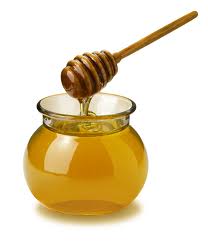Midlife Wellness: Honey for Healing
 Bees make honey when the enzymes in their stomachs react with the nectar of flowers. It is made up primarily of glucose together with fructose and is twice as sweet as sugar. You can substitute 1/2 – 3/4 cup honey for 1 cup of sugar in recipes.
Bees make honey when the enzymes in their stomachs react with the nectar of flowers. It is made up primarily of glucose together with fructose and is twice as sweet as sugar. You can substitute 1/2 – 3/4 cup honey for 1 cup of sugar in recipes.
In its raw, unfiltered/minimally filtered state, honey is a concentrated source of essential nutrients such as some minerals, B-complex vitamins and vitamins C, D and E.
Aside from being used for sweetening foods and beverages, honey is also used to promote energy and healing. Germs don’t grow well in honey which makes it a natural antiseptic and a good salve for burns and wounds.
Researchers at the University of Sydney found that when diluted honey is applied to a moist wound, it produces hydrogen peroxide, a known anti-bacterial agent. Further research revealed that honey may be a natural remedy for some of the hospital “superbugs” that are resistant to antibiotics.
Honey has been used for many centuries. The ancient Greeks, the Romans and the Egyptians were great proponents of using the golden gooey stuff. My favorite way to use it is for a sore throat or cough. I put a teaspoon or so in a cup of hot tea along with some lemon juice. According to my husband, the brew works much better if you add rum!
Pure, uncontaminated honey is greatly underutilized these days as a healing remedy. However, there are marked differences in the antibacterial activity of different types of honey. Manuka honey, made by bees in New Zealand, has been found to have the most healing properties of any honey on the market.
A word of warning: NEVER give honey of any type to an infant under one year of age. In its natural form it can contain spores of the bacteria that cause botulism. This poses no problem for healthy adults and older children unless it happens to be tainted honey smuggled in from China. I was mortified when I read a recent article about “honey smuggling.” It seems that this honey can contain illegal antibiotics and heavy metals. Not only that, but some products marked as honey have almost no honey in them. They are a mix of sugar water, malt sweeteners, corn or rice syrup, jaggery (coarse unrefined sugar from the sap of certain palm trees), barley malt sweetener or other additives with just a small amount of actual honey.
If you use honey and buy it from a supermarket, I suggest you read the article at http://www.foodsafetynews.com/2011/08/honey-laundering/
